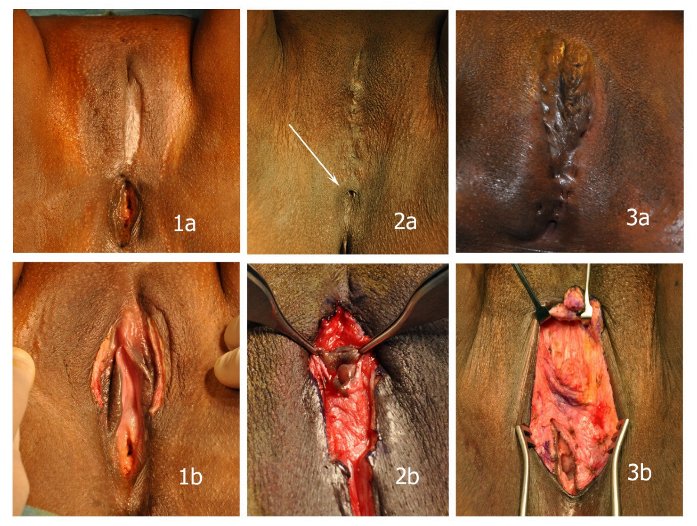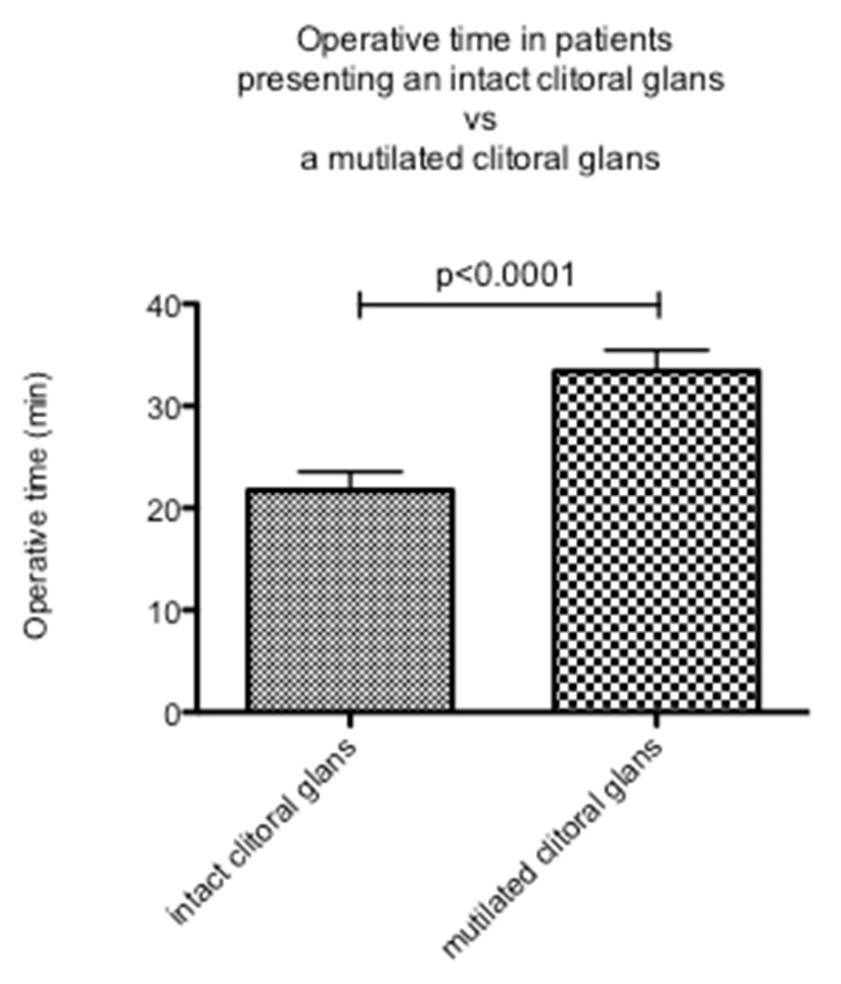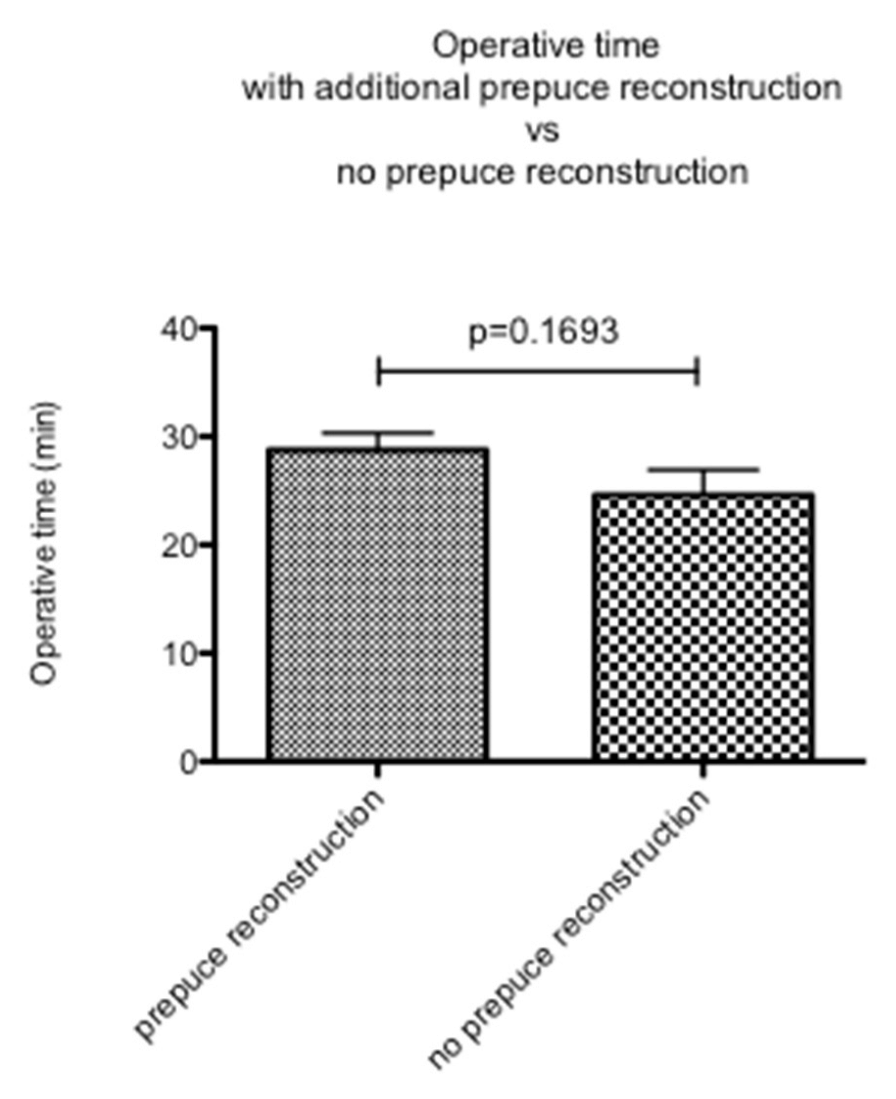Postoperative Course of Reconstructive Procedures in FGM Type III-Proposal for a Modified Classification of Type III Female Genital Mutilation
Abstract
1. Introduction
1.1. Current WHO Classification of Female Genital Mutilation
- Type I: Also referred to as Sunna or CircumcisionPartial or total removal of the clitoral glans, and/or the prepuce/clitoral hood
- o
- Type Ia. Removal of the prepuce/clitoral hood only.
- o
- Type Ib. Removal of the clitoral glans with the prepuce/clitoral hood.
- Type II: Partial or total removal of the clitoral glans and the labia minora, with or without removal of the labia majora.
- o
- Type IIa. Removal of the labia minora only.
- o
- Type IIb. Partial or total removal of the clitoral glans and the labia minora (prepuce/clitoral hood may be affected).
- o
- Type IIc. Partial or total removal of the clitoral glans, the labia minora and the labia majora (prepuce/clitoral hood may be affected).
- Type III: Also referred to as pharaonic circumcision or InfibulationNarrowing of the vaginal opening with the creation of a covering seal. The seal is formed by cutting and repositioning the labia minora or labia majora. The covering of the vaginal opening is done with or without removal of the clitoral prepuce/clitoral hood and glans (Type I FGM).
- o
- Type IIIa. Removal and repositioning of the labia minora.
- o
- Type IIIb. Removal and repositioning of the labia majora.
- Type IV. All other harmful procedures to the female genitalia for non-medical purposes, for example pricking, piercing, incising, scraping and cauterization
1.2. Proposal for a Modified Classification of Type III Female Genital Mutilation
- Type III:
- o
- Type IIIa. Partial or total removal and repositioning of the labia minora.
- o
- Type IIIac. Partial or total removal and repositioning of the clitoral glans and of the labia minora.
- o
- Type IIIb. Partial or total removal and repositioning of the labia majora.
- o
- Type IIIbc. Partial or total removal and repositioning of the clitoral glans and of the labia majora
- o
- Type IIIc. Partial or total removal and repositioning of the labia minora and labia majora
- o
- Type IIIcc. Partial or total removal and repositioning of the clitoral glans and of the labia minora and labia majora.
- Type IIIx: preoperative examination does not allow for a complete classification due to the overlaying scar after infibulation
2. Methods
2.1. Patients
2.2. Surgery
2.3. Statistics
3. Results
4. Discussion
5. Conclusions
Author Contributions
Funding
Institutional Review Board Statement
Informed Consent Statement
Data Availability Statement
Conflicts of Interest
References
- Ortensi, L.E.; Farina, P.; Leye, E. Female genital mutilation/cutting in Italy: An enhanced estimation for first generation migrant women based on 2016 survey data. BMC Public Health 2018, 18, 129. [Google Scholar] [CrossRef] [PubMed]
- Equality EIfG. Estimation of Girls at Risk of Female Genital Mutilation in the European Union: Stepby-Step Guide (2nd ed.) 2019. Available online: https://eige.europa.eu/publications/estimation-girls-risk-female-genital-mutilation-european-union-step-step-guide-2nd-edition (accessed on 30 September 2022).
- Sigurjonsson, H.; Jordal, M. Addressing Female Genital Mutilation/Cutting (FGM/C) in the Era of Clitoral Reconstruction: Plastic Surgery. Curr. Sex. Health Rep. 2018, 10, 50–56. [Google Scholar] [CrossRef] [PubMed]
- Mohamed, F.S.; Wild, V.; Earp, B.D.; Johnson-Agbakwu, C.; Abdulcadir, J. Clitoral Reconstruction After Female Genital Mutilation/Cutting: A Review of Surgical Techniques and Ethical Debate. J. Sex. Med. 2020, 17, 531–542. [Google Scholar] [CrossRef] [PubMed]
- Wulfes, N.; von Fritschen, U.; Strunz, C.; Kröhl, N.; Scherer, R.; Kröger, C. Cognitive-Emotional Aspects of Post-Traumatic Stress Disorder in the Context of Female Genital Mutilation. Int. J. Environ. Res. Public Health 2022, 19, 4993. [Google Scholar] [CrossRef]
- Johnsdotter, S. The Impact of Migration on Attitudes to Female Genital Cutting and Experiences of Sexual Dysfunction Among Migrant Women with FGC. Curr. Sex. Health Rep. 2018, 10, 18–24. [Google Scholar] [CrossRef]
- Gele, A.A.; Sagbakken, M.; Kumar, B. Is female circumcision evolving or dissolving in Norway? A qualitative study on attitudes toward the practice among young Somalis in the Oslo area. Int. J. Women’s Health 2015, 7, 933–943. [Google Scholar] [CrossRef]
- Catania, L.; Abdulcadir, O.; Puppo, V.; Verde, J.B.; Abdulcadir, J.; Abdulcadir, D. Pleasure and Orgasm in Women with Female Genital Mutilation/Cutting (FGM/C). J. Sex. Med. 2007, 4, 1666–1678. [Google Scholar] [CrossRef]
- Abdulcadir, J.; Rodriguez, M.I.; Petignat, P.; Say, L. Clitoral Reconstruction After Female Genital Mutilation/Cutting: Case Studies. J. Sex. Med. 2015, 12, 274–281. [Google Scholar] [CrossRef]
- Abayomi, O.; Chibuzor, M.T.; Okusanya, B.O.; Esu, E.; Odey, E.; Meremikwu, M.M. Supportive psychotherapy or client education alongside surgical procedures to correct complications of female genital mutilation: A systematic review. Int. J. Gynecol. Obstet. 2017, 136 (Suppl. 1), 51–55. [Google Scholar] [CrossRef]
- Adelufosi, A.; Edet, B.; Arikpo, D.; Aquaisua, E.; Meremikwu, M.M. Cognitive behavioral therapy for post-traumatic stress disorder, depression, or anxiety disorders in women and girls living with female genital mutilation: A systematic review. Int. J. Gynecol. Obstet. 2017, 136 (Suppl. 1), 56–59. [Google Scholar] [CrossRef]
- Thabet, S.M.A.; Thabet, A.S. Defective sexuality and female circumcision: The cause and the possible management. J. Obstet. Gynaecol. Res. 2003, 29, 12–19. [Google Scholar] [CrossRef]
- Nour, N.M.; Michels, K.B.; Bryant, A.E. Defibulation to treat female genital cutting: Effect on symptoms and sexual function. Obstet. Gynecol. 2006, 108, 55–60. [Google Scholar] [CrossRef]
- Foldès, P.; Cuzin, B.; Andro, A. Reconstructive surgery after female genital mutilation: A prospective cohort study. Lancet 2012, 380, 134–141. [Google Scholar] [CrossRef]
- Seifeldin, A. Genital Reconstructive Surgery after Female Genital Mutilation. Obstet. Gynecol. Int. J. 2016, 4, 1–4. [Google Scholar] [CrossRef]
- Gutierrez-Ontalvilla, P.; Andjelkov, K.; Ruiz-Valls, A. Invited Discussion on: Clinical and Patient Reported Outcomes of 19 Patients Undergoing Clitoral and Labial Reconstruction After Female Genital Mutilation/Cutting. Aesthetic Plast. Surg. 2021, 46, 478–479. [Google Scholar] [CrossRef]
- Berg, R.C.; Taraldsen, S.; Said, M.A.; Sørbye, I.K.; Vangen, S. The effectiveness of surgical interventions for women with FGM/C: A systematic review. BJOG Int. J. Obstet. Gynaecol. 2018, 125, 278–287. [Google Scholar] [CrossRef]
- Abdulcadir, J.; Rodriguez, M.I.; Say, L. A systematic review of the evidence on clitoral reconstruction after female genital mutilation/cutting. Int. J. Gynecol. Obstet. 2015, 129, 93–97. [Google Scholar] [CrossRef]
- Abdulcadir, J.; Rodriguez, M.; Say, L. Research gaps in the care of women with female genital mutilation: An analysis. BJOG Int. J. Obstet. Gynaecol. 2015, 122, 294–303. [Google Scholar] [CrossRef]
- RCOG. Female Genital Mutilation and Its Management, RCOG Green-Top Guideline No.53 2015 [Updated 29.09.2022. RCOG Release: Updated Guidelines Provide Clarity for Healthcare Professionals on the Care of Women with FGM]. Available online: https://www.rcog.org.uk/media/au0jn5of/gtg-53-fgm.pdf (accessed on 1 October 2022).
- NHS. Clinical Commissioning Policy Statement: Genital Surgery to Improve Clitoral Sensation for Women Who Have Undergone Female Genital Mutilation. Available online: https://www.england.nhs.uk/commissioning/wp-content/uploads/sites/12/2015/01/e10-surgcl-trt-fgm.pdf (accessed on 29 September 2022).
- Chappell, A.G.; Sood, R.; Hu, A.; Folsom, S.M.; Wafford, Q.E.; Bowen, D.K.; Post, L.A.; Jordan, S.W. Surgical management of female genital mutilation-related morbidity: A scoping review. J. Plast. Reconstr. Aesthetic Surg. 2021, 74, 2467–2478. [Google Scholar] [CrossRef]
- Botter, C.; Sawan, D.; SidAhmed-Mezi, M.; Spanopoulou, S.; Luchian, S.; Meningaud, J.-P.; Hersant, B. Clitoral Reconstructive Surgery After Female Genital Mutilation/Cutting: Anatomy, Technical Innovations and Updates of the Initial Technique. J. Sex. Med. 2021, 18, 996–1008. [Google Scholar] [CrossRef]
- Chang, C.S.; Low, D.W.; Percec, I. Female Genital Mutilation Reconstruction: A Preliminary Report. Aesthet. Surg. J. 2017, 37, 942–946. [Google Scholar] [CrossRef] [PubMed]
- Christopher, A.N.; Othman, S.; Morris, M.P.; Broach, R.B.; Percec, I. Clinical and Patient-Reported Outcomes of 19 Patients Undergoing Clitoral and Labial Reconstruction After Female Genital Mutilation/Cutting. Aesthetic Plast. Surg. 2022, 46, 468–477. [Google Scholar] [CrossRef] [PubMed]
- Niranjan, N.S. Perforator Flaps for Perineal Reconstructions. Semin. Plast. Surg. 2006, 20, 133–144. [Google Scholar] [CrossRef]
- Berg, R.C.; Taraldsen, S.; Said, M.A.; Sørbye, I.K.; Vangen, S. Reasons for and Experiences with Surgical Interventions for Female Genital Mutilation/Cutting (FGM/C): A Systematic Review. J. Sex. Med. 2017, 14, 977–990. [Google Scholar] [CrossRef] [PubMed]
- Abdulcadir, J.; Tille, J.-C.; Petignat, P. Management of painful clitoral neuroma after female genital mutilation/cutting. Reprod. Health 2017, 14, 22. [Google Scholar] [CrossRef]
- WHO. Types of Female Genital Mutilation. Available online: https://www.who.int/teams/sexual-and-reproductive-health-and-research-(srh)/areas-of-work/female-genital-mutilation/types-of-female-genital-mutilation (accessed on 29 September 2022).
- von Fritschen, U.; Strunz, C.; Scherer, R. Female Genital Mutilation/-Cutting. In Intimchirurgie, 1st ed.; Mirastschijski, U., Remmel, E., Eds.; Springer: Berlin/Heidelberg, Germany, 2019; pp. 117–125. [Google Scholar]
- Abdulcadir, J.; Marras, S.; Catania, L.; Abdulcadir, O.; Petignat, P. Defibulation: A Visual Reference and Learning Tool. J. Sex. Med. 2018, 15, 601–611. [Google Scholar] [CrossRef]
- WHO. Guidelines on the Management of Health Complications from Female Genital Mutilation 2016. Available online: https://www.who.int/publications/i/item/9789241549646 (accessed on 29 September 2022).
- Ismail, S.A.; Abbas, A.M.; Habib, D.; Morsy, H.; Saleh, M.A.; Bahloul, M. Effect of female genital mutilation/cutting; types I and II on sexual function: Case-controlled study. Reprod. Health 2017, 14, 108. [Google Scholar] [CrossRef]




| n= | IIIa | IIIac | IIIb | IIIbc | IIIc | IIIcc | |
|---|---|---|---|---|---|---|---|
| Somalia | 65 | 26 | 13 | 6 | 2 | 10 | 8 |
| Egypt | 1 | 0 | 0 | 0 | 0 | 0 | 1 |
| Ethiopia | 3 | 1 | 0 | 1 | 0 | 0 | 1 |
| Burkina Faso | 1 | 0 | 0 | 0 | 0 | 0 | 1 |
| Kenya | 1 | 0 | 0 | 1 | 0 | 0 | 0 |
| Eritrea | 3 | 0 | 3 | 0 | 0 | 0 | 0 |
| Djibouti | 2 | 1 | 0 | 0 | 0 | 1 | 0 |
| Sudan | 4 | 0 | 1 | 1 | 1 | 1 | 0 |
| Gambia | 2 | 0 | 2 | 0 | 0 | 0 | 0 |
| Sierra Leone | 2 | 0 | 2 | 0 | 0 | 0 | 0 |
| Nigeria | 1 | 0 | 1 | 0 | 0 | 0 | 0 |
| Total | 85 | 28 | 22 | 9 | 3 | 12 | 11 |
| Country of Origin | Number of Patients | Percentage of Type III Mutilation |
|---|---|---|
| Somalia | 197 | 33% |
| Egypt | 10 | 10% |
| Ethiopia | 10 | 30% |
| Burkina Faso | 9 | 11% |
| Kenya | 15 | 7% |
| Eritrea | 21 | 14% |
| Djibouti | 5 | 40% |
| Sudan | 12 | 33% |
| Gambia | 11 | 18% |
| Sierra Leone | 18 | 11% |
| Nigeria | 16 | 6% |
| Other | 103 | |
| Total | 427 |
| n= | Mean (min) | |
|---|---|---|
| Total of | 85 | 26.4 |
| Clitoral resection | 34 | 33.4 |
| No clitoral resection | 51 | 21.8 |
| Formation prepuce | 36 | 28.8 |
| No formation prepuce | 49 | 24.6 |
| Clitoral resection and formation prepuce | 19 | 32.4 |
| Clitoral resection and no formation prepuce | 15 | 34.8 |
| No clitoral resection formation prepuce | 17 | 24.7 |
| No clitoral resection, no formation of prepuce | 34 | 20.2 |
Disclaimer/Publisher’s Note: The statements, opinions and data contained in all publications are solely those of the individual author(s) and contributor(s) and not of MDPI and/or the editor(s). MDPI and/or the editor(s) disclaim responsibility for any injury to people or property resulting from any ideas, methods, instructions or products referred to in the content. |
© 2023 by the authors. Licensee MDPI, Basel, Switzerland. This article is an open access article distributed under the terms and conditions of the Creative Commons Attribution (CC BY) license (https://creativecommons.org/licenses/by/4.0/).
Share and Cite
von Fritschen, U.; Strunz, C.; Scherer, R.; von Fritschen, M.; Fricke, A. Postoperative Course of Reconstructive Procedures in FGM Type III-Proposal for a Modified Classification of Type III Female Genital Mutilation. Int. J. Environ. Res. Public Health 2023, 20, 4439. https://doi.org/10.3390/ijerph20054439
von Fritschen U, Strunz C, Scherer R, von Fritschen M, Fricke A. Postoperative Course of Reconstructive Procedures in FGM Type III-Proposal for a Modified Classification of Type III Female Genital Mutilation. International Journal of Environmental Research and Public Health. 2023; 20(5):4439. https://doi.org/10.3390/ijerph20054439
Chicago/Turabian Stylevon Fritschen, Uwe, Cornelia Strunz, Roland Scherer, Marisa von Fritschen, and Alba Fricke. 2023. "Postoperative Course of Reconstructive Procedures in FGM Type III-Proposal for a Modified Classification of Type III Female Genital Mutilation" International Journal of Environmental Research and Public Health 20, no. 5: 4439. https://doi.org/10.3390/ijerph20054439
APA Stylevon Fritschen, U., Strunz, C., Scherer, R., von Fritschen, M., & Fricke, A. (2023). Postoperative Course of Reconstructive Procedures in FGM Type III-Proposal for a Modified Classification of Type III Female Genital Mutilation. International Journal of Environmental Research and Public Health, 20(5), 4439. https://doi.org/10.3390/ijerph20054439







